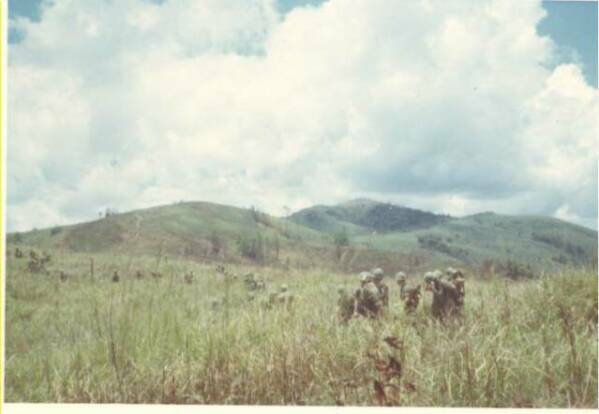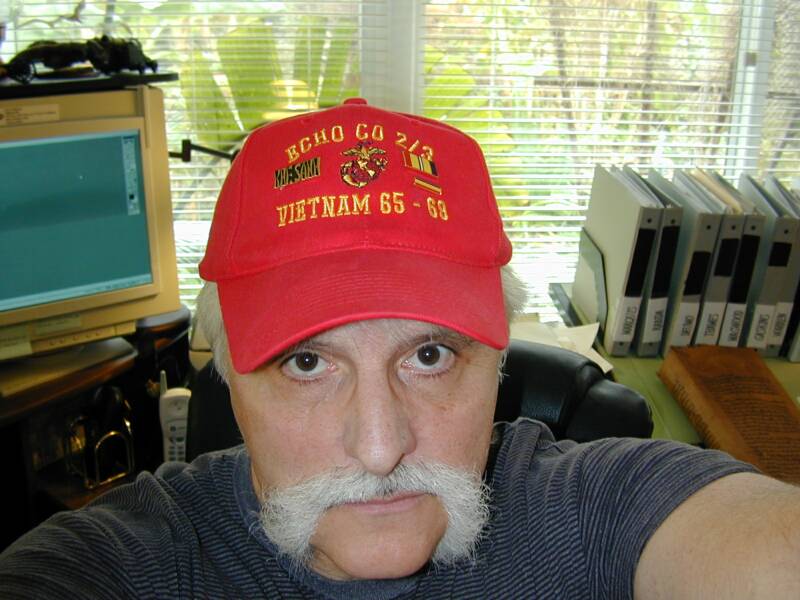Until now, there had been no prisoners taken. It didn't surprise anyone. With the anger built up in our Marines and the tenacity with which the NVA fought, I didn't expect any. From somewhere God only knows where word came that "Pappy" Delong would give 20 days R & R to the man who got him a prisoner. Within minutes, we had three. From these three, it was learned that another NVA division was on its way south to retake the hill complex. It was this division that would overrun Lang Vei several nights later.
I was on pins and needles. I wanted to reach my two squads that were still up there. I prayed that some were still alive, but everyone knew there was no hope. Still, I wanted to pull them out. Marines always pull out their dead and wounded. Firing was still going on. We continued to wait.
Finally, I pulled my third squad leader back and informed him of what I was about to do. I told him to get the third squad on their bellies; that we were going to crawl back over the crest of the hill and take up the first and second squads' position. I told him that, upon reaching those positions, we would watch out for Hotel Company and, should they approach, mark their positions with air panels. We would kill everyone who wasn't Marine. With the help of 2nd Lt. Carroll's platoon, we did just that. The lst Platoon also helped. Where was Hotel Company? Out there somewhere, I guess.
The fighting continued and at about 11:30 that morning, 3 May 1967, we reached our forward positions. The look on Morningstar's fact as he crawled out of his bunker was one of disbelief. After all, he had been in the midst of hell for well over seven hours and survived. He would be KIA (killed in action) two months later by a single shot from a sniper's rifle.
I surveyed the first and second squads' positions. Only then did I realize the strength with which the enemy had attacked. There were bodies everywhere, mostly NVA. In front of my first and second squads lay about 80 North Vietnamese bodies. The remainder of the hill was literally strewn with bodies. There was no telling how many had been dragged off or died later from this fight. I could not tell black Marines from white Marines. They were all black. Without circulation of the blood, bodies lying in that hot sun for hour hours became parched and blackened.
It appeared that my first squad leader had set off his claymores at the most opportune time. It was also apparent that both squads had been overwhelmed. It was into these two squads that the main thrust of the enemy attack had been launched. I should have cried but I didn't. I didn't have time. I would cry later, and when I did, the tears would never completely stop. The memory of these Marines so young, so brave would stay with me forever.
The official body count of the dead NVA was 137 but we stacked 236 weapons including AK-47's, Russian assault machine guns, mortars, Russian sniper rifles, and SKS carbines. On top of the hill, just behind my bunker, I found a dead NVA. Strapped around his neck was a rectangular metal box. Half of the box contained a radio and radio equipment. The other half contained cooked rice. They had come to stay. They stayed
With 2nd Lt. Carroll's platoon now attached to our company, we reestablished our defensive perimeter. At the same time, we continued to mop up, account for our casualties, and treat those wounded who would not be medevaced. We had to be resupplied and replenished with ammo. Our company gunnery sergeant, GySgt. David F. Johnson, did a super job.
After we helilifted our dead and wounded out, I sat down with out first sergeant, "Top" Charles Patrinos, who was sitting on a log near the XO's old position. It was then I learned several of the men I thought were dead had been medevaced out with wounds. In my platoon alone, I had 11 KIA and 17 WIA (wounded in action). I had an additional 5 WIA not evacuated. Morningstar had attempted to come out of the bunker sometime earlier and had been hit in the hand. He was not medevaced. The two wounded in the same bunker were. My radioman, Lance Corporal Hovietz, was also wounded but not medevaced. My third squad remained intact.
Shortly after accounting for my casualties, one of the men from my third squad reported that someone was coming down the hill behind us, waving a white flag. We didn't need any more prisoners. POW taking time had expired. I told two of my men to sight in on him and when he got close enough, waste him. They didn't. The closer he came, the more he looked like an American. Who was he? Our Marines didn't wear tiger stripes. He kept coming, waving his flag. My two men kept him in their sights even as he walked into our lines. He was a damn redheaded, freckled-faced, freelance photographer and journalist. He wanted a story but we all had too much to do and had no time for story telling. After a while, he got discouraged and left. Who knows maybe he went north.
About 1500 that afternoon, the battalion commander flew in by helicopter to appraise the situation. First Lieutenant Jack Adinolfi had assumed command of the company. Members of the company were still mopping up. After summarizing all that had taken place, I rejoined my platoon in the mopping-up operations.
While extending our fields of fire, and improving our positions, I found a bunker that was freshly dug and camouflaged. Lying inside the bunker entrance was a dead North Vietnamese officer. Several others were inside. I went over to where "Pappy" Delong was and told him I would be getting him a souvenir, a North Vietnamese officer's pistol. He was pleased.
I returned to the bunker to get the pistol, but as I approached, the muzzle of an AK-47 came out firing. I hit the deck and rolled. The AK-47 disappeared back into the bunker. I had one of my fire teams cover me while I tossed a grenade into the bunker, after which I crawled back to the bunker entrance. Again, the muzzle of the AK-47 came out firing. Playtime was over. I called for the engineers. I told the engineer squad leader to rig me up a satchel charge; that I wanted an entire bag of C-4. The bag contained four packages of the plastic explosive. I knew that when this blew, no one would ever find the pistol, but then too, afterwards, this bunker could definitely be considered friendly.
I had the fire team provide me covering fire while I crawled close enough to the entrance to pull the fuse and throw the charge in. As I threw the charge into the bunker and rolled away, the fire team opened up to prevent the NVA from throwing the charge back out. I estimated there to be about seven NVA in the bunker. No one will ever know for sure. When the charge went off, chunks of earth, pieces of bodies, and other debris were scattered all over the hillside.
I went back to where Lt. Col. Delong was sitting and apologized for not being able to get the pistol for him. Nothing that was in the bunker before the blast could be found. I guess I used too much C-4. "Pappy" didn't seem to mind.
During those hours, from 0400 to 1100 that morning, I witnessed much bravery from many of our troops. One in particular was that of SSgt. David L. Noakes, Platoon sergeant of the 1st Platoon. I recall him being badly wounded. I ordered him back to the medevac area to be medevaced. Instead, he made trip after trip up near the fighting to bring out the wounded Marines. Then there was PFC Meuse, my first squad radioman who, after being hit in the chest but continuing to fight died in his fighting hole. After finally reaching his position that morning, I stood there for the longest time wishing I could have reached him in time. I remember thinking, "My God, how young he was." Then, too, there was PFC Johnson, who sat upon the side of his bunker eating peanut butter as if nothing were happening, bullets flying all over the place. I thought I had lost him, too, but not from wounds. He would later distinguish himself in an assault on a fortified position south of Con Thien.
As night drew closer, we intensified our efforts to strengthen our positions. This could be the night the North Vietnamese division that was moving south might hit. We would be ready.
The status of our positions that night was as follows: Our XO, lst Lt. Jack Adinolfi, had assumed command of the company and was now the company commander. We were without an XO. My platoon was strengthened to 17 men with the addition of one gun team and one rocket team. Our portion of the defense extended from 10 to 2. Second Lieutenant Carroll's platoon would defend from 2 to 6 and 2nd Lt. Eller's platoon would defend from 6 to 10. Second Lieutenant Izenour's 1st Platoon would fill any gaps and constitute the company reserve. Second Lieutenant Carroll's platoon would revert back to Foxtrot Company the following morning. Although sporadic fire continued throughout the night, nothing major occurred and the night passed with no additional casualties.
Morning came and we were anxious to get the hell off the hill. The stench from the NVA bodies was becoming almost unbearable. Beyond us to the north stood Hill 881N.

Approach to Hill 881
Paul Marquis Web Master
& proud member of Echo Company

 | ||||||
 | ||||||

 | ||||||